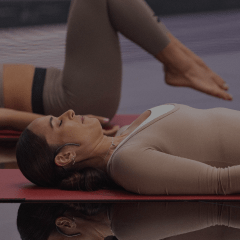Any new mom knows that finding time to focus on yourself is hard – and if you’re breastfeeding it can be even harder. But dedicating some of your precious time to physical activity can pay dividends. Exercise provides neurological benefits across the board, helping nurture mental well-being and ease anxiety and stress. Research shows postpartum women who gradually return to exercise four to six weeks after delivery report lower depression and anxiety than those who do not meet the guidelines for physical activity.
However, despite the very clear benefits of exercise, there is still a lot of confusion and inaccuracies around the impact of physical activity on breastfeeding.
The number one thing to remember is the old cliché, listen to your body. No two women will have the same pregnancy, birth and postpartum experience. So you can only focus on what feels right for you. Do whatever you've got to do to get through the tough early stages of parenthood, and enjoy as much physical activity as you can without sacrificing you and your baby's health and sanity. If you want some help, keep these pointers front of mind.

Dee Rowell, Les Mills Trainer and mother
Maintain a healthy diet
Once you start breastfeeding, you will likely experience an increase in appetite. And guess what? It’s all good! Your body is officially working overtime to make milk and keep all regular functions going, so eating a little extra is to be expected. This is especially true for women who work out. You need added calories to help you keep producing milk and restricting calorie intake can be detrimental to your milk supply – so don’t diet, make the milk! Trainer and mom of two, Dee Rowell prioritizes lots of protein and carbohydrates. “I’ve found that oats help increase my milk supply, so I always have porridge in the morning.” Fellow trainer and new mom, Natasha Vincent also turns to oats and bananas to help her milk supply and boost her energy levels. “Things like porridge and smoothies are also great before I exercise. Surprisingly, I have cravings for this type of nutritious food, it’s like my body knows I need the extra energy!”
“I’ve found that oats help increase my milk supply, so I always have porridge in the morning.” Dee Rowell, Trainer
Stay hydrated
Dehydration can be one of the fastest ways to reduce milk volume and interfere with the quality of your breast milk. So if you want to maintain your optimal milk supply, drinking lots of water is key. When you add exercise into the mix your body’s fluid requirements increase, so you need to drink even more to stay hydrated. Be sure to work out with a drink bottle by your side, and drink plenty of water before, during and after your exercise. If you want to spice things up, flavor your water with berries and mint, citrus, or even sliced apples. You can also try other fluids. Dee drinks a lot of coconut water as she has found it keeps her hydrated and helps improve her milk supply.
“Walking and short workouts can create real change. You might not feel like you’re moving forward, but as soon as you step back, you realize how much progress you’ve made.” Natasha Vincent, Trainer

Natasha Vincent, Les Mills Trainer and mother
Make yourself comfortable
You want to feel good while you're working out, so do a little pre-workout prep to help make things as enjoyable as possible. Dee says making sure you feed or pump before any exercise is her biggest tip. Natasha also says this is key to a good workout. “In those first few months, I would give him a good feed, then put him to sleep, and then I would work out. It helped me physically feel more comfortable, and I could relax more knowing that he was sleeping – although he is a notorious catnapper!”
Both Dee and Natasha also say finding a supportive bra is imperative. “I have small breasts naturally, and I could wear any type of bra and feel good. But it’s very different having fuller breasts and working out how to move your body around them. Nowadays, a supportive bra is a must,” says Dee.
Blending comfort and innovation, adidas’ Stay In Play PowerImpact Maternity Bra helps breastfeeding mothers stay comfortable and active. Featuring adidas’ Stay In Play technology, the bra helps provide protection from leaks, while providing optimum comfort and flexibility throughout the post-partum journey. SHOP ADIDAS
Don't dial up the intensity too much
Whether exercise affects milk supply has been the topic of much debate. For the most part, studies show that moderate activity like walking and yoga enhance the physical and mental wellbeing of new mothers without influencing milk production. However, when new mothers push themselves with high-intensity workouts or demanding training regimes, there is a chance milk supply can drop. “I didn't see any major fluctuations,” says Natasha. "But when I reintroduced high intensity workouts to my schedule, the day after I felt like my milk was less than it would be after a standard core or strength workout."
Dee explains that her first daughter was exclusively breastfed, but her second daughter prefers to feed from the bottle, so Dee spends much of her time pumping her breastmilk into bottles, which gives her a much better measure of her milk supply. Doing her regular routine of running, weights and Pilates she hadn’t noticed any fluctuations in supply. However, when she embarked on an intensive week of exercise filming new LES MILLS™ workouts, the extra demands she put on her body led to a big dip in supply. "It definitely highlighted to me how too much intensity can deplete you!"
“It definitely highlighted to me how too much intensity can deplete you!” Dee Rowell, Trainer
Avoid adding to the exhaustion
If you’ve just pulled an all-nighter, you know what won’t help? Sprints. What will help? Yoga and a walk with the pushchair. Have a think about what your body’s done during pregnancy and birth, and give yourself a break. You’ve earned a bit of rest and recovery. Let go of any pressure to get back to the fitness level you were pre-baby and remind yourself, that you don't need to destroy yourself to feel that healthy hit of endorphins.
Dee knows you can’t pour from an empty cup, and focuses on being kind to herself during this special season of life. That has meant tweaking her training to focus on more restorative ways to move. “Now I run and do some light strength training and I love Pilates, because I feel like I get a good workout yet it doesn't leave me feeling absolutely smashed.”
Natasha admits that it took her a while to come to grips with the lighter training load. "I was thinking, how am I going to get back to teaching classes if I am only walking and managing two low-impact 15-minute workouts a week?". Now, back teaching and reflecting on those early months, she realizes the regular walks and short workouts were actually all she needed to create change. "When you're in it, you don't feel like you're moving forward, but as soon as you step back you realize how much progress you've made."
“I still only work out 2 or 3 times a week, and on the days I don't train I am good with that. I now know there’s nothing wrong with having a day in and recharging so that you can be the best for yourself and your baby.”
The Les Mills post-pregnancy workouts can help you slowly ease back into exercise.
Check them out here.
Watch and learn about more joyous moments and challenges that other mothers have experienced embracing different ways to feed.








